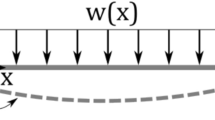Abstract
Differential equations (DEs) are important mathematical models for describing natural phenomena and engineering problems. Finding analytical solutions for DEs has theoretical and practical benefits. However, traditional methods for finding analytical solutions only work for some special forms of DEs, such as separable variables or transformable to ordinary differential equations. For general nonlinear DEs, analytical solutions are often hard to obtain. The current popular method based on neural networks requires a lot of data to train the network and only gives approximate solutions with errors and instability. It is also a black-box model that is not interpretable. To obtain analytical solutions for DEs, this paper proposes a symbolic regression algorithm based on genetic programming with the simplification-pruning operator (SP-GPSR). This method introduces a new operator that can simplify the individual expressions in the population and randomly remove some structures in the formulas. Moreover, this method uses multiple fitness functions that consider the accuracy of the analytic solution satisfying the sampled data and the differential equations. In addition, this algorithm also uses a hybrid optimization technique to improve search efficiency and convergence speed. This paper conducts experiments on two typical classes of DEs. The results show that the proposed method can effectively find analytical solutions for DEs with high accuracy and simplicity.
This work was partly supported by the National Natural Science Foundation of China under Grant No. 62276222.
Access this chapter
Tax calculation will be finalised at checkout
Purchases are for personal use only
Similar content being viewed by others
References
Bar-Sinai, Y., Hoyer, S., Hickey, J., Brenner, M.P.: Learning data-driven discretizations for partial differential equations. Proc. Natl. Acad. Sci. 116(31), 15344–15349 (2019)
Bomarito, G., Townsend, T., Stewart, K., Esham, K., Emery, J., Hochhalter, J.: Development of interpretable, data-driven plasticity models with symbolic regression. Comput. Struct. 252, 106557 (2021)
Brenner, M.: Machine learning for partial differential equations. In: APS March Meeting Abstracts, vol. 2021, pp. P61–003 (2021)
Bueno-Orovio, A., Pérez-García, V.M., Fenton, F.H.: Spectral methods for partial differential equations in irregular domains: the spectral smoothed boundary method. SIAM J. Sci. Comput. 28(3), 886–900 (2006). https://doi.org/10.1137/040607575
Cao, L., Jiang, M., Feng, L., Lin, Q., Pan, R., Tan, K.C.: Hybrid estimation of distribution based on knowledge transfer for flexible job-shop scheduling problem. In: 2022 4th International Conference on Data-driven Optimization of Complex Systems (DOCS), pp. 1–6. IEEE (2022)
Deb, K., Pratap, A., Agarwal, S., Meyarivan, T.: A fast and elitist multiobjective genetic algorithm: NSGA-II. IEEE Trans. Evol. Comput. 6(2), 182–197 (2002)
Denis, B.: An overview of numerical and analytical methods for solving ordinary differential equations. arXiv preprint arXiv:2012.07558 (2020)
Eymard, R., Gallouët, T., Herbin, R.: Finite volume methods. Handb. Numer. Anal. 7, 713–1018 (2000)
Henner, V., Nepomnyashchy, A., Belozerova, T., Khenner, M.: Partial differential equations. In: Ordinary Differential Equations: Analytical Methods and Applications, pp. 479–545. Springer, Cham (2023)
Hernandez, A., Balasubramanian, A., Yuan, F., Mason, S.A., Mueller, T.: Fast, accurate, and transferable many-body interatomic potentials by symbolic regression. NPJ Comput. Mater. 5(1), 112 (2019)
Hong, H., Jiang, M., Feng, L., Lin, Q., Tan, K.C.: Balancing exploration and exploitation for solving large-scale multiobjective optimization via attention mechanism. In: 2022 IEEE Congress on Evolutionary Computation (CEC), pp. 1–8. IEEE (2022)
Hong, H., Jiang, M., Yen, G.G.: Improving performance insensitivity of large-scale multiobjective optimization via Monte Carlo tree search. IEEE Trans. Cybern. (2023)
Jiang, M., Wang, Z., Guo, S., Gao, X., Tan, K.C.: Individual-based transfer learning for dynamic multiobjective optimization. IEEE Trans. Cybern. 51(10), 4968–4981 (2020)
Karpatne, A., et al.: Theory-guided data science: a new paradigm for scientific discovery from data. IEEE Trans. Knowl. Data Eng. 29(10), 2318–2331 (2017)
Meuris, B., Qadeer, S., Stinis, P.: Machine-learning-based spectral methods for partial differential equations. Sci. Rep. 13(1), 1739 (2023)
Oh, H., Amici, R., Bomarito, G., Zhe, S., Kirby, R., Hochhalter, J.: Genetic programming based symbolic regression for analytical solutions to differential equations. arXiv preprint arXiv:2302.03175 (2023)
Sacchetti, A., Bachmann, B., Löffel, K., Künzi, U., Paoli, B.: Neural networks to solve partial differential equations: a comparison with finite elements. IEEE Access 10, 32271–32279 (2022). https://doi.org/10.1109/ACCESS.2022.3160186
Wang, Z., Hong, H., Ye, K., Zhang, G.E., Jiang, M., Tan, K.C.: Manifold interpolation for large-scale multiobjective optimization via generative adversarial networks. IEEE Trans. Neural Netw. Learn. Syst. (2021)
Ying, L.: Partial differential equations and the finite element method. Math. Comput. 76(259), 1693–1694 (2007). https://www.ams.org/journals/mcom/2007-76-259/S0025-5718-07-02023-6/home.html
Author information
Authors and Affiliations
Corresponding author
Editor information
Editors and Affiliations
Rights and permissions
Copyright information
© 2024 The Author(s), under exclusive license to Springer Nature Singapore Pte Ltd.
About this paper
Cite this paper
Cao, L., Zheng, Z., Ding, C., Cai, J., Jiang, M. (2024). Genetic Programming Symbolic Regression with Simplification-Pruning Operator for Solving Differential Equations. In: Luo, B., Cheng, L., Wu, ZG., Li, H., Li, C. (eds) Neural Information Processing. ICONIP 2023. Communications in Computer and Information Science, vol 1962. Springer, Singapore. https://doi.org/10.1007/978-981-99-8132-8_22
Download citation
DOI: https://doi.org/10.1007/978-981-99-8132-8_22
Published:
Publisher Name: Springer, Singapore
Print ISBN: 978-981-99-8131-1
Online ISBN: 978-981-99-8132-8
eBook Packages: Computer ScienceComputer Science (R0)




